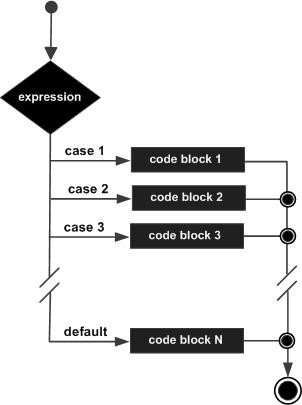Switch Statement in C++ language
- The second of C++’s selection statements is the switch.
- The switch provides for a multiway branch. Thus, it enables a program to select among several alternatives.
- Although a series of nested if statements can perform multiway tests, for many situations the switch is a more efficient approach.
- A switch statement allows a variable to be tested for equality against a list of values. Each value is called a case, and the variable being switched on is checked for each switch case.
Syntax
switch(integer expression)
{
case constant 1 :
do this ;
case constant 2 :
do this ;
case constant 3 :
do this ;
default :
do this ;
}
Flow Diagram

Example
// platters.cpp
// demonstrates SWITCH statement
#include using namespace std;
int main()
{
int speed; //turntable speed
cout << “
Enter 33, 45, or 78: “;
cout > speed; //user enters speed
switch(speed) //selection based on speed
{
case 33: //user entered 33
cout << “LP album
”;
break;
case 45: //user entered 45
cout << “Single selection
”;
break;
case 78: //user entered 78
cout << “Obsolete format
”;
break;
}
return 0;
}
Output:
Enter 33, 45, or 78:
45
Single selection
